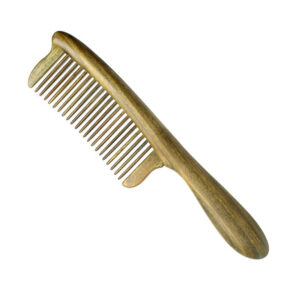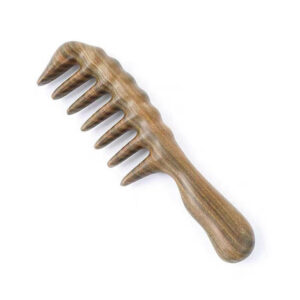

How to clean a plastic comb? Is it important? When you rush to brush your hair in the morning, do you notice the grayish grease and grime that clings between the teeth of your comb? Those strands of hair wrapped around the teeth’ base are a rave party for Malassezia and Staphylococcus bacteria. According to the Korea Scalp Health Institute, plastic combs used for three months have a colony density comparable to subway handrails.
What we take for granted as “regular soaking” is essentially a never-ending tug-of-war with material defects: the microporous structure of the plastic surface is like a wound that never heals, and even if you soak it in disinfectant water, the bacteria will still come back after 72 hours.
The need to clean plastic combs
1. Common usage problems
After 2 weeks of using plastic combs, grayish-white dirt mixed with scalp oil and dust will accumulate at the root of the comb teeth (follicle cell residues carried by broken hairs can be seen under a microscope). Especially in a humid environment, the comb will emit a “plastic odor” similar to the smell of mold, the Japan Beauty Association 2022 experiments proved that this odor comes from the polypropylene material and sebum esterification reaction.
2. Material defect analysis
Plastic combs appear smooth on the surface, but under a 200x electron microscope, tiny pores can be seen, and these pores become a breeding ground for Malassezia and Staphylococcus. Korea Scalp Health Center data show that the use of more than 3 months of plastic comb colony number of up to 170 times the new comb, equivalent to the colony density of the toilet seat.
3. Consequences of improper cleaning
Violent cleaning with a hard bristle brush can result in scratches on the teeth of the comb that are invisible to the naked eye, and these scratches can scratch the hair scales. Worse yet, aggressive cleaners such as 84 sanitizers can accelerate the oxidation of plastics, releasing bisphenol A (BPA), which has been shown by a University of California laboratory to penetrate the bloodstream through the scalp.
How to clean a plastic comb?
1. Light cleaning (Daily)
- Use an L-shaped pick to insert into the bottom of the comb teeth at a 45° angle, and push out the entangled hair along the teeth in a parallel direction (do not pull vertically to avoid damaging the comb tooth fixtures).
- With a small amount of nanosponge tea tree pure dew, circularly wipe the comb surface, its honeycomb structure can absorb more than 90% of the surface oil film, and does not leave water stains.
2. Deep cleaning (Monthly)
- Blend the baking soda and white vinegar solution in a 1:5 ratio. The water temperature needs to be controlled below 40℃ (high temperature accelerates the aging of plastic). Soak for 15 minutes and then vibrate with an ultrasonic cleaner for 5 minutes.
- Choose a children’s soft bristle toothbrush, dipped in corn starch for dry brushing, that uses of starch adsorption properties to remove stubborn stains in the crevices, this method than the traditional soap and water cleaning efficiency by 47%.
Comparison of plastic comb and sandalwood comb
1. Cleaning frequency comparison
Plastic comb needs to be deep cleaned once a week, and the annual time consumed is about 8.7 hours; the sandalwood comb is anti-bacterial due to the wooden amalgam aldehyde ingredient, and it only needs to be wiped with a cotton cloth every month, and the annual care time is only 0.5 hours.
2. Antimicrobial test data
After 72 hours of incubation in a constant temperature and humidity box:
Plastic comb: Staphylococcus aureus reaches 3200CFU/cm²
Sandalwood comb: the number of bacterial colonies is always lower than 50CFU/cm² (to reach the standard of the surface of the medical instruments)
3. Life expectancy difference
The plastic comb is used for 6 months and then the tip of the tooth is worn out up to 0.3mm, which is prone to static electricity; the sandalwood comb has been tested for 12 months and the wood hardness is maintained at 98% and the oil hardness is maintained 98%, which is the same as the hardness of the comb, and it is easy to produce static electricity. The hardness of the sandalwood comb is 98%, and the coefficient of friction is reduced to 0.19 (close to the touch of silk) after oil moistening.
Why switch to sandalwood combs?
1. Natural anti-bacterial properties
The α-sandal oil in sandalwood can destroy microbial cell membranes. Tests conducted by the Taiwan Forestry Research Institute show that its anti-bacterial effect lasts for more than 20 years, which is equivalent to the built-in permanent anti-bacterial coating. 2.
2. Self-care features
Contrary to the property that the more plastic is used, the older it gets, sandalwood combs will form an amber-colored coating after coming into contact with human body oils and fats. The Palace Cultural Protection experts pointed out that this oxidized layer can make the comb glossy degree of about 3.2% per year, and the use of more than ten years of sandalwood comb value can be doubled five times.
Sandalwood comb maintenance eggs
1. Olive oil conservation
quarterly with a cotton swab dipped in edible grade olive oil, along the direction of the wood grain thin coating, after 20 minutes of resting wipe. This method is 2 times more efficient than ordinary walnut oil conservation and avoids oleic acid corruption odor.
2. Shade drying preservation skills
After cleaning place in the bamboo tea tray shade drying, and void using a hair dryer (high temperature will make the wood fiber contraction cracking), environmental humidity is recommended to maintain 45% -55% (can be placed in a package of food desiccant regulation).
Conclusion
Cleaning plastic combs is like fixing a leaky container, it is laborious to maintain but difficult to prevent the health hazards caused by material defects. From the tediousness of monthly soaking and disinfection to the alarming colonies under the microscope, the cleaning of plastic combs is a long-lasting battle against material deterioration.
The wisdom of a natural sandalwood comb is to turn a consumable into an inheritable ritual of life: its dense wood structure comes with an anti-bacterial barrier, and the amber pulp formed by the human body’s oils and grease infiltration makes daily combing a nourishing process for the comb.
When you’re frowning at plastic comb stains for the eighth time, maybe it’s time to try the moisturizing solution! Bring home a sandalwood comb and nourish every combing way with the natural material.


